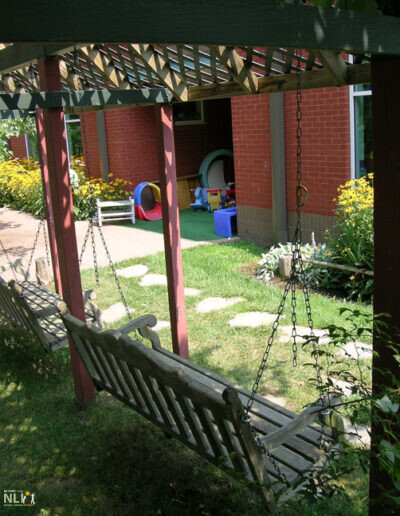11. Shade Solutions
Adequate protection from the sun is essential for the health and comfort of young children outdoors. In addition to protecting children from harmful ultra-violet light, sun protection extends outdoor play and learning opportunities by prolonging time spent in the outdoor learning environment (OLE). A diversity of shade elements in a naturalized play area ensures that an OLE reaches it’s maximum potential, enriching each play setting with sun protection and comfort for both children and teachers.
Trees
Having a sufficient number of trees is crucial to achieve best practice sun-protection within an OLE. Trees anchor play settings and create cool, comfortable micro-climates where children can spend extending time learning outdoors. To achieve OLE best practice, a diversity of trees is recommended, with a preference for small and medium-sized trees which are scaled to young children. To approximate the number of trees required for an OLE, use the following formula, rounding to the nearest whole number:
Area of OLE in square feet, divided by 600.
To ensure a diversity of trees, follow the guidelines below:
- 10—15% canopy/shade trees
- 15—25% evergreen trees
- 30—40% small-medium under-story trees
- 15—25% fruiting trees
Trees require time to mature before they can provide adequate shade, making shade structures or temporary shading solutions necessary for outdoor play. The following shade settings include vegetated, structural, and temporary solutions that respond to OLE needs, including budget, volunteer availability, and space limitations.
Shrubs, vines, and ornamental grass
While waiting for trees to grow to maturity, planting a variety of other vegetation can help an OLE meet it’s shade requirements and add sensory variety to outdoor play settings.
Shrubs. Perennial shrubs installed next to a play setting where children sit for extended periods can provide much-needed pockets of shade. Cluster large shrubs around decks, sand play settings, and gathering areas to create well-defined plays settings. Edible shrubs, such as blueberries, add additional play value.
Vines. Whether grown on fences, teepees, pergolas, or tunnels, vines create a naturalized, shady play setting. Vining edible plants, such as pole beans, are low-cost and easy to maintain—once planted, they’ll grow quickly and define a sensory playspace for children.
Ornamental Grass. Tall perennial grass, such as common rush, can create rich, textural shade settings for children to hide and play in. Planted in clusters, ornamental grass can create a maze for children to endlessly explore.
PERMANENT STRUCTURES
Arbors, pergolas, tunnels, and trellises scattered throughout the outdoor learning environment create patches of shade and comfortable, three-dimensional spaces scaled to young children. Structures can be custom built or purchased as kits. Permanent structures may be expensive to install, but they become attractive play settings in their own right.
Arbors. An arbor usually incorporates a trellis into its structure, creating a rounded, tunnel-like passageway of climbing plants. Arbors can be designed around a primary pathway, creating a shady and exciting moment for children engaged in active play. Arbors can also mark the entrances and exits of different play areas, creating a distinct identity for an OLE.
Pergolas. Pergolas also support climbing plants and create shady environments, but they typically have posts that support an open, roof-like structure. Pergolas are often built to shade an outdoor classroom, deck, or swing (Figure 5).
Trellises. A trellis is a plant-supporting structure made of an interwoven lattice of wood, metal, or bamboo. Trellises provide an architectural foundation for climbing plants to grow in a desired fashion, creating green walls, tunnels, shelters, sculptures, and other outdoor fixtures.
Tunnels. Made from PVC, netting, live willow-fencing, or metal wire armature, tunnels are a sensory and adventurous play setting for children in an outdoor environment. A large willow tunnel can serve as a peaceful gathering setting or an adventurous hideaway, while a tunnel of edible vines can provide endless opportunities for exploration, tasting, and play.
TEMPORARY STRUCTURES
Vegetation takes time to grow, and permanent structures take time and money to build— if your OLE needs instant, temporary shade, consider the following solutions:
- Pop-up canopy
- Sheet/tarp attached to a fence or tent poles
- Umbrella
- Bamboo teepee and fabric
- Cardboard box playhouse






